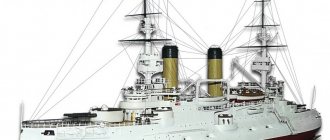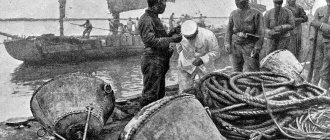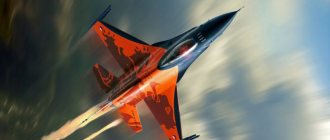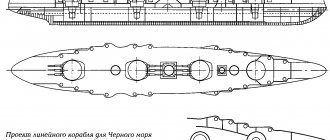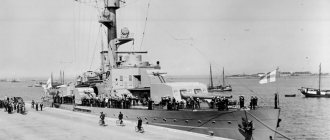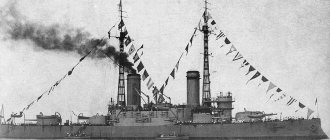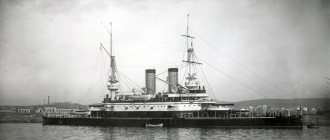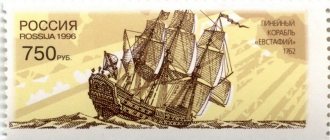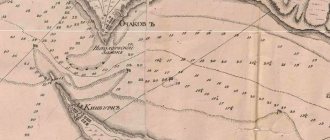“Retvizan” vs “Tsesarevich”, or why not Crump?
Those interested in the history of the Russian fleet are well aware of the caricatured image of Charles Crump, drawn in a number of sources, where the American shipbuilder is presented as an assertive businessman who came to St. Petersburg with grandiose plans for profit.
Having learned about the participation in the upcoming international competition of “the most famous shipbuilding firms in Europe” and realizing his uncompetitiveness, the unprincipled American, in order to conclude contracts for the construction of a battleship and a cruiser, bypassing the competition, allegedly went to give bribes to the head of the Main Directorate of Shipbuilding and Supply (hereinafter GUKiS) Vice Admiral V P. Verkhovsky and the Chief of the Fleet and the Naval Department, Admiral General Alexei Alexandrovich. But what if, through the prism of that era, we try to look at the circumstances associated with the order of the future “Retvizan” and “Varyag” with an unbiased look? Following the Sino-Japanese War of 1894–1895 and the Triple Intervention by Germany, Russia, and France, which resulted in the victorious country's humiliating refusal to annex the Liaodong Peninsula, Japan began to build up its military power in preparation for further confrontations. In December 1895, the Japanese Parliament approved the “Post-War Program” for strengthening the navy, which provided for the commissioning by 1906 of 119 warships with a total displacement of about 146,495 tons, including four I-class battleships, six I-class armored cruisers , five class II cruisers, 11 fighters and 89 destroyers of I-III classes. Initially, during the implementation of the “Program,” it was planned to spend 93,978,509.00 yen, taken from the indemnity received from China, the total amount of which was 364,482,305.00 yen. The process of implementing the program planned by the Japanese could not help but attract the attention of outside observers. Thus, in July 1897, an international congress of the British “Society of Naval Designers and Marine Engineers” was held in England, where, among others, Charles H. Cramp and assistant class inspector at the Technical School of the Naval Department, junior shipbuilder P. E. Chernigovsky. Being old acquaintances, later at the shipyard they together inspected the warships being built for foreign customers, including the battleships Yashima and Hatsuse, as well as the armored cruiser Asama, which impressed the American. The fact of the construction of these ships was known to the Russian naval agent in England, Captain 1st Rank K.I. Grigorovich, apparently, this circumstance was the reason for the visit to the world's largest shipyard by engineer Chernigovsky.
At the end of 1897, when the battleships "Shikishima", "Asahi" and "Hatsuse", as well as the armored cruisers "Asama", "Tokiwa", "Adzuma" and "Yakumo" were at the slipway stage of construction, at a Special meeting of the highest ranks of the Marine Ministry, held under the chairmanship of Admiral General Grand Duke Alexei Alexandrovich, formulated the basic requirements for the project of a new battleship (according to the plan, “enlarged Poltava”). The displacement was no more than 12,000 tons, the speed increased to 18 knots, the main armament of the ship was supposed to be four 12″ and twelve 6″ guns. A few weeks later, the Marine Technical Committee (hereinafter referred to as MTK) began work on the “Design Program” of the battleship or, in modern language, tactical and technical specifications, the final version of which, along with the above elements, included a cruising range of up to 5,000 miles at a ten-knot speed and twenty 75-mm and 47-mm guns.
On February 23, 1898, Emperor Nicholas II approved the new shipbuilding “Program for the needs of the Far East” developed by the Ministry of the Navy, which provided for the construction of five squadron battleships, 16 cruisers, two minelayers and 36 destroyers. In addition to the financial estimate of the Maritime Ministry for 1898, amounting to 67,500,000.00 rubles, according to the personal imperial decree of February 24, 1898, a “Special loan” was additionally allocated for the needs of the “Program” under § “Special” in the amount of 90,000,000 .00 rubles.
On the eve of the planned international competition on March 14, 1898, at a Special Meeting, it was “decided in principle” to use the Peresvet project as a prototype for new battleships, increasing the caliber of the main artillery from 10″ to 12″, replacing the three-shaft power plant with a two-shaft one and abandoning the wooden and copper plating of the underwater part of the hull. Competitive invitations were sent to a number of foreign shipbuilding companies in advance, to which two responded: the Italian “Gio. Ansaldo & C" and the German "Schiff- und Maschinenbau-AG "Germania"", which were objectively outsiders in European shipbuilding at that time. Apparently, this was also the reason why the competition was not held, since given the lack of experience among the emerging participants in designing and building modern battleships, there was no point in it.
Long before the events described above, the Russian side initiated a long business correspondence with Ch. Crump, which was conducted by Vice Admiral N. I. Kaznakov (chief commander of the Kronstadt port and at the same time the military governor of Kronstadt, who held this position for more than six years, after which at the end of 1899 year he was replaced by Vice Admiral N. O. Makarov) and other senior officials of the fleet, as a result of which in the early spring of 1898 the head of the American shipyard received a message that the Naval Ministry of the Russian Empire “would be happy to consider” his plans and proposals for construction "at least two 1st class battleships, two 1st class protected cruisers with the highest speed and thirty destroyers" in accordance with the new shipbuilding program, which had already been finally authorized by the ministry and approved by Emperor Nicholas II a few weeks ago.
C. Crump arrived in St. Petersburg in early March 1898, where over the next few weeks bilateral discussions took place with the chief inspectors of shipbuilding, mechanical engineering, artillery, mines and the construction part of the MTK on the widest possible range of topics, as a result of which a common agreement was reached agreement on all important issues and Crump was given the “Design Program” for the battleship. The construction of a shipyard in Port Arthur was also discussed: T. Seligman, a member of the board of the Belgian company John Cockerill, shortly before Crump’s departure to Russia, informed the latter about the proposal made by the Russian side to build his company a shipyard in the Far East, the amount the transaction was preliminary estimated at 30,000,000.00 francs (about 7,500,000.00 rubles). The American’s visit took place against the background of increased business activity of agents and experts representing the interests of French and German shipyards in Russia, supported by the embassies and banks of their countries that had influence at the royal court, and here Ethan Allen Hitchcock provided all possible support and assistance to Charles Crump. , US Ambassador Extraordinary and Plenipotentiary to Russia, who energetically defended the interests of American industrial circles. Following the results of meetings held at the end of March with Ch. Crump, Admiral General Grand Duke Alexei Alexandrovich and Chief of the Main Naval Staff F. K. Avelan approved the construction in America of a squadron battleship and cruiser of the 1st rank, contracts for the construction of which were signed in Philadelphia on April 11, 1898 of the year. A few weeks later, St. Petersburg was once again visited by A. Lagane (Antoine-Jean Amable Lagane), chief designer and director of the shipyard of the Forges et chantiers de la Méditerranée society, and on May 26, 1898, the chairman of the MTK, Adjutant General I.M. Dikov, along with a covering letter, received a preliminary design and preliminary specification of the battleship, drawn up by a French engineer in accordance with the requirements of the ministerial “Design Program”. Ignoring the “decision in principle” of the Special Meeting, Lagan used the battleship “Jauréguiberry” with a turret arrangement of medium artillery as a prototype, which, in turn, did not raise objections from the MTK, two months ago, in pursuance of the “decision in principle” of the Special Meeting, which rejected Crump’s proposal as a prototype, the turret-mounted battleship "Iowa" in favor of the turret-casemate "Peresvet". Soon the French project was approved by the MTK, after which on July 8, 1898, the head of the GUKiS, Vice Admiral V.P. Verkhovsky signed a contract with Lagan for the construction of a squadron battleship, which on January 11, 1899 was officially named “Tsesarevich”.
Armadillo "Jaureguiberry"
Battleship Iowa
In addition to two foreign ones, it was received by the Baltic and Mechanical Plant of the Maritime Department. Four variants of the project, later submitted to the MTK for consideration, developed by the senior assistant of the shipbuilder V. Kh. Offenberg, the captain of the corps of naval engineers K. Ya. Averin, as well as the junior assistants of the shipbuilder M. V. Shebalin and N. N. Kuteinikov, they represented further the development of the battleship "Peresvet", however, even before signing the contract with A. Lagan, were immediately rejected by the Admiral General, who, on a non-alternative basis, appointed the French project as a prototype when developing a design for the program "Battleships No. 2-8" of a series of five battleships (battleship No. 1 - “Victory”).
What actually underlay this decision is unknown, formally “the original reservation was mainly in the underwater part of the hull”
.
However, the unequal conditions in which the two foreign shipbuilding yards were located, as well as the fundamental rejection of the idea of a domestic project for a promising battleship, allow us to make an assumption about the political background of the order of the future “Tsesarevich” in France, a country that periodically lent sums amounting to hundreds of millions of gold rubles to the Russian government. and with which in 1892 Russia concluded a military convention and established close military-technical cooperation. In addition, there were rumors about corruption on the part of the head of the Naval Ministry, Vice Admiral P. P. Tyrtov, and the Chief of the Fleet and Naval Department, Grand Duke Alexei Alexandrovich. Whether this is actually the case will forever remain a mystery, but the patronizing and inexplicably condescending attitude of the Maritime Department towards Lagan is significant indirect evidence in support of such an assumption.
Lagan, unlike Crump, was spared the need to conduct grueling discussions in the MTK for weeks. The project of the main caliber towers proposed by the American company for the sake of maintaining “uniformity of the material part” was rejected by the customer in favor of domestic installations, at the same time the French shipyard received the right to install on the “Tsesarevich” towers designed for battleships of the “Charlemagne” type, thereby the Metal Plant was deprived of a profitable order (502,000.00 rubles), and the fleet is deprived of uniformity of material. The contract deadline for the delivery of “Retvizan” was calculated from the moment the supervisory commission arrived in America (arriving in Philadelphia two months after signing the contract), and “Tsesarevich” - from the date of final approval of the MTK drawings (ten and a half months after signing the contract). If William Cramp & Sons undertook to build Retvizan in 30 months, then Forges et chantiers de la Méditerranée immediately announced a 48-month period, later reduced to 46 months. The explanation given by R. M. Melnikov is “the actual recognition that a purely turret battleship is no less than one and a half times more labor intensive than turret-casemate type battleships.”
.
However, this hypothesis is refuted by practice, which built the tower battleship Iowa in forty-six months and the tower-casemate battleship Maine in forty-six and a half months.
Battleship "Maine"
At the same time, the contract price of the two battleships was comparable ($3,010,000.00 and $2,885,000.00, respectively). Threats of a fine to Crump, caused by failure to meet contract deadlines, were withdrawn only after the latter stated to the Admiral General that there were already buyers for the Retvizan, including one that offered one million dollars more than the contract value of the ship. Lagan, who also missed contract terms, was not threatened with fines. But “Tsesarevich”, accepted in gross violation of contractual norms, unlike “Retvizan”, left for Port Arthur with an extensive list of deficiencies, which served as the basis for delaying the last payment in the amount of 2,000,000.00 francs. It is unknown when all the problems were finally eliminated, but the French specialists who arrived in Port Arthur on board the battleship began to prepare to eliminate the main one (the capriciousness of the ammunition supply system for main-caliber guns) in mid-December 1903, i.e. fifty-five months after the start of the contract period for the delivery of the Tsarevich. The manager of the Naval Ministry, Vice Admiral F.K. Avelan, started talking with the Minister of Finance, Count V.N. Kokovtsev, about the payment of the last, delayed payment for the Tsarevich a year later, on December 17, 1904. Noteworthy is the higher cost per ton of displacement of the Tsarevich compared to the Retvizan.
This contrast is all the more striking since the wages of workers at the two shipyards were different. The minimum daily wage at a French shipyard ranged from one to three francs, the maximum - from four to seven. At the same time, at the American shipyard, chasers, ship carpenters, blacksmiths, etc. received 18 dollars (93.29 francs) per week, and coachmen and drillers - from 10 to 10.5 dollars (from 51.82 to 54.42 francs ) in Week. Lagan's personnel policy was that the vast majority of its workers were unemployed Italian shipbuilders who came to work in France and were accustomed to being content with little; as a result, they often received less for their work than even their colleagues in Russia, where workers of the New Admiralty, for example, Those employed in the construction of the squadron battleship Oslyabya received an average of 1.03 rubles (4 francs) per day in 1897, with the maximum daily earnings reaching two rubles (8 francs).
It is interesting that the gap in wages between American and French shipbuilders was matched by the daily allowances that GUKiS paid to those overseeing the construction of two battleships for the same period of time, in 1900 amounting to 244 days. Captain 1st rank I.K. Grigorovich received “travel allowances” in France totaling 4,748.82 rubles, and captain 1st rank E.N. Shchensnovich received 7,417.40 rubles in the USA.
A commonplace in domestic sources has become accusations against Crump of giving a bribe in order to conclude a contract bypassing the “international competition” and subsequent extortion by the “subtle cunning” of over-contract sums for replacing the types of deck and vertical armor of the Retvizan, so let’s consider these points in detail.
The correspondence initiated by the Maritime Ministry with the American shipbuilder did not imply the latter’s participation in an “international competition” that had not even been conceived; for this in the future it would be enough to simply send him an invitation. The idea to organize a competition appeared after contact was initiated with an American regarding the construction of a number of warships for the Russian fleet in the United States.
As for vertical armor, the official documents of the Congress and the US Navy at our disposal reveal a different picture, different from the usual one that has long become textbook for the domestic reader. As is known, at the end of the 19th century, American metallurgical companies repeatedly supplied armor to Russia at a price lower than for US Navy ships under construction. Krupp's armor for the Retvizan was no exception, the average price of which was several tens of dollars lower than the cost of Harvey's armor supplied to the battleships Kearsarge and Kentucky, for example. The latter carried garveyized nickel armor, the price of which, depending on the manufacturer, as well as the configuration, thickness and weight of the plates, ranged from 525 to 638 dollars per ton. Turning to domestic sources supplements the above with details missing from the American sources available to us.
S. A. Balakin:
“...using insufficiently clear wording in the contract, he agreed to fulfill the customer’s conditions only subject to additional payment. After another series of bickering, the parties somehow came to an agreement. The 229-mm Krupp plates were contracted to be manufactured by the American company, and the 178-mm, 152-mm, 127-mm and deck armor were contracted to be manufactured by the Carnegie Steel Company. For this, the Russian Maritime Ministry had to “fork out” 310 thousand dollars in excess of the amount agreed upon in the contract.”
However, the facts are such that in fact the amount named by Balakin was paid extra only for the deck armor, not only of the Retvizan, but also of the Varyag. As the historian of shipbuilding and fleet R.M. Melnikov wrote almost half a century ago in the magazine “Shipbuilding”:
“The order for deck armor for the cruiser caused a conflict with the company. For its delivery from extra-soft nickel steel, which was accepted at that time, Crump, referring to the contract, demanded an additional payment. Changing the type of armor on a battleship and a cruiser cost the ministry $310,000.”
For the deck armor of the “Varyag” they paid an additional $85,000; on the “Retvizan” a similar additional payment amounted to $225,000.00, for a total of $310,000.00. To replace Harvey’s armor with Krupp’s armor, we repeat, the Navy Department did not have to pay extra to the Americans.
The low cost of building the Retvizan (compared to the Tsarevich) against the backdrop of higher costs than in France for American labor and American building materials cannot but raise reasonable doubts about the economic feasibility of the alleged bribery by the American. On the contrary, these circumstances allow us to say that by now the narrative that declared the conclusion of contracts with Ch. Crump as a consequence of the personal interest of the head of the State Administration for Civil Engineering and Services V.P. Verkhovsky and Admiral General Alexei Alexandrovich has exhausted its plausibility.
Battleship "Retvizan"
Battleship "Tsesarevich"
The limitations of the necessary information available in the sources available to us do not allow us to conduct a full comparison of “Tsarevich” and “Revizan”, so we are forced to limit ourselves to only a few aspects. The design features of the compared battleships are such that in a real combat situation, the Tsarevich, despite the presence of original mine protection, found itself in a more dire situation than other torpedoed Port Arthur ships. The torpedo hit the aft part of the left side of the Tsesarevich near the beginning of the stern tube; the epicenter of the explosion was approximately 2.74 meters below the waterline and fell against the ship's arsenal. As a result of the explosion, a hole with an area of 18.5 square meters was formed, the total area of the deformed area was 46.45 square meters. The Tsarevich took up to 2,000 tons of water, its maximum roll reached 18 degrees, at the same time, according to the calculations of the chief naval engineer of the port R.R. Svirsky and the French engineer Coudreau, an additional increase in the roll by half a degree. The vigorous counter-flooding of nine compartments at once, carried out before the threshold of loss of stability, helped to avoid a disaster.
The effect of a torpedo hitting the battleship "Tsesarevich"
As a result of a torpedo hitting the left side of the Retvizan, a hole with an area of about 15 square meters was formed in the area of the underwater torpedo tube and the adjacent torpedo magazine. The epicenter of the explosion was about 2.5 meters below the waterline, the total area of the area deformed by the explosion was about 37 square meters. Three compartments with a total capacity of 2,200 tons were filled with water (according to other sources, 2,500 tons), by the time the ship began to straighten as a result of counter-flooding of the right cellars, the roll reached 11 degrees (the artillery ports of the Retvizan entered the water at 12 degrees).
The effect of a torpedo hitting the battleship "Retvizan"
The armor weight of the “Tsesarevich” is 3347.8 tons, while that of the “Retvizan” the same figure was 3300 tons. The waist armor (490 square meters and 346 square meters, respectively) of the Tsarevich covered a much larger freeboard area than that of the Retvizan. But the Retvizan casemates of 6″ guns were protected on the outside by armor plates with a total area of about 128 square meters; In addition, the side of the battleship at the extremities over an area of about 170 square meters was covered with armor plates 51 mm thick. The armor area of the Tsarevich's medium-caliber towers, depending on the angle of rotation, ranged from 33 square meters to 27 square meters. Thus, the total armoring areas of the two battleships, excluding the main caliber turrets, were noticeably different from each other, amounting to 517-523 square meters on board for the Tsarevich and 644 square meters for the Retvizan. It is impossible to say for sure which of the two systems is better, since both have their own advantages and disadvantages. But in the conditions of the Russo-Japanese War, taking into account the Japanese’s reliance mainly on high-explosive shells that exploded at the slightest delay, the distribution of armor on the Retvizan looks more preferable.
Distribution of armor on the Tsarevich
Distribution of armor on the Retvizan
Footnotes [edit]
- Jump up
↑ McLaughlin 2003, pp. 100–103 - Jump up
↑ McLaughlin 2000, pp. 48–51 - Jump up
↑ McLaughlin 2000, p. 51 - Jump up
↑ McLaughlin 2000, pp. 52–53 - Jump up
↑ McLaughlin 2000, pp. 54–55 - Jump up
↑ McLaughlin 2000, p. 55 - ^a bc McLaughlin 2000, p. 57
- Friedman, p. 261
- Jump up
↑ McLaughlin 2000, pp. 57–58 - Friedman, p. 264
- ^ a b c d e McLaughlin 2000, p. 58
- Friedman, p. 228
- Friedman, p. 120
- Forczyk, pp. 27-28, 57
- Jump up
↑ McLaughlin 2000, p. 53 - ^a bc McLaughlin 2000, p. 61
- Jump up
↑ McLaughlin 2000, p. 54 - “The new Russian battleship is a record holder.” The Philadelphia Inquirer
. October 19, 1901 p. 3. - Jump up
↑ McLaughlin 2000, pp. 54, 57, 59 - Jump up
↑ Westwood, pp. 15–21 - Jump up
↑ McLaughlin 2000, pp. 61, 63 - ↑
Warner & Warner, pp. 305–306. - ^ a b McLaughlin 2000, p. 63
- Forczyk, pp. 51-52
- Forcik, page 53
- Forcik, page 52
- Chenault and Kolesnik, p. 183
- ^a bc McLaughlin 2000, p. 64
- ^ abcde Lengerer, page 59
- Silverstone, page 329
- Lengerer, pp. 57-59
- ^a bc McLaughlin 2008, p. 63
Links[edit]
- Chesneau, Roger & Kolesnik, Eugene M., eds. (1979). Conway's World Warships 1860–1905. Greenwich, UK: Conway Maritime Press. ISBN 0-8317-0302-4.
- Forczyk, Robert (2009). Russian battleship versus Japanese battleship, Yellow Sea 1904–05
. Botley, UK: Osprey. ISBN 978-1-84603-330-8. - Friedman, Norman (2011). Naval weapons of the First World War
. Barnsley, South Yorkshire, UK: Seaforth. ISBN 978-1-84832-100-7. - Lengerer, Hans (September 2008). Ahlberg, Lars (ed.). "Hidzen (ex-Retvizan)." Contributions to the History of Japanese Imperial Warships
(Document V): 57–59.(subscription required) (contact the editor at for subscription information) - McLaughlin, Stephen (September 2008). Ahlberg, Lars (ed.). "Retvizan". Contributions to the History of Japanese Imperial Warships
(Document V): 60–63.(subscription required) - McLaughlin, Stephen (2000). Preston, Anthony (ed.). Retvizan: an American battleship for the Tsar
. Warship. 2000–2001 London: Conway Maritime Press. pp. 48–65. ISBN 0-85177-791-0. - McLaughlin, Stephen (2003). Russian and Soviet battleships
. Annapolis, MD: Naval Institute Press. ISBN 1-55750-481-4. - Silverstone, Paul H. (1984). Directory of the World's Capital Ships
. New York: Hippocrene Books. ISBN 0-88254-979-0. - Warner, Denis and Warner, Peggy (2002). Tide at Dawn: A History of the Russo-Japanese War, 1904–1905.
(2nd ed.). London: Frank Cass. ISBN 0-7146-5256-3. - Westwood, J. N. (1986). Russia vs. Japan, 1904–1905: The Russo-Japanese War Revisited
. Albany, NY: State University of New York. ISBN 0-88706-191-5.
